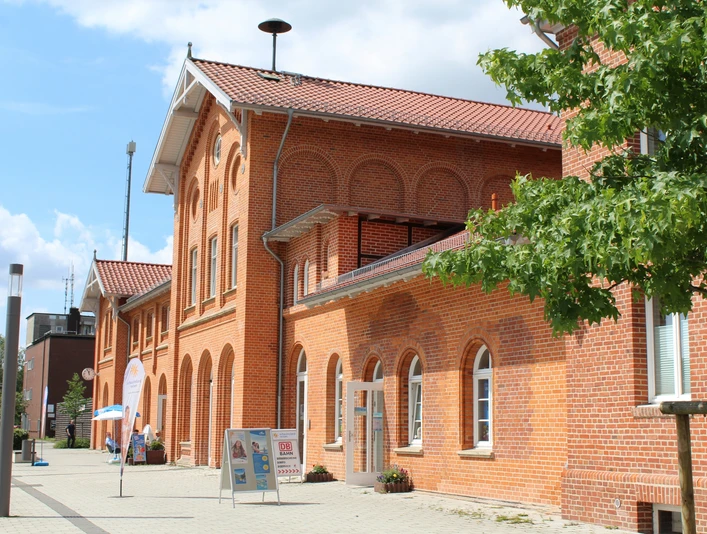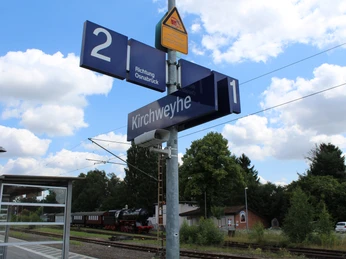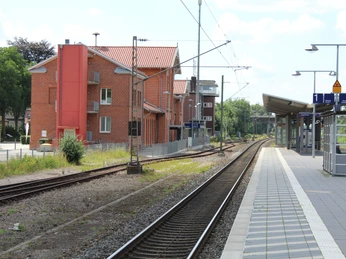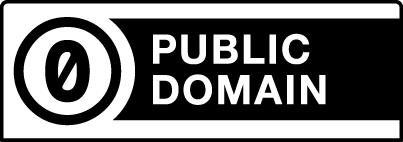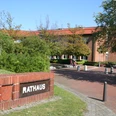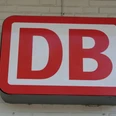The centrepiece is the station building. It was essentially built shortly before the completion of the Bremen-Osnabrück railway line, which was opened in 1873 as part of the "Hamburg-Venlo Railway". While the historicist building was given a roof in the Swiss style, which was very popular at the time, the architect took inspiration from Romanesque and Gothic brickwork as well as Renaissance architecture when designing the façade.
The station was of outstanding importance for the "North German Rollbahn", the shortest rail link between the Rhenish-Westphalian industrial area and the two seaports and shipbuilding centres of Hamburg and Bremen. From 1907 to 1915, it was expanded in two stages to become one of the largest marshalling yards in north-west Germany and Prussia. While the Kirchweyher railway area originally covered 6.2 hectares, it expanded to around 57 hectares after the end of the First World War. Every day, up to 5,000 wagons were assembled here to form new goods trains.
The expansion made the railway station the largest employer in Weyhe's history. In 1919, almost 1500 people were employed here in operations and railway maintenance services as well as in transport, locomotive and workshop services. A considerable proportion of the workforce had been recruited due to the immense transport tasks that had to be handled by the railway during the First World War.
The population of the once tranquil parish village of Kirchweyhe had doubled since the opening of the railway line. At the beginning of the 1920s, around 70 per cent of the now 3,500 inhabitants lived in railway households. New residential buildings, new streets and new businesses had sprung up around the railway facilities. A distinct club culture had developed and political life had been given new impetus by local labour movement organisations.
In the early 1920s, there were plans to expand the marshalling yard once again and extend the Haltern-Kirchweyhe railway line to four tracks. The station building was to be relocated as part of these measures. However, the project never materialised. Instead, the Bremen and Hamburg facilities were significantly improved through major remodelling. In addition, the separation of freight wagons sent from the Ruhr region to Bremen and Hamburg now often took place in the area of the Reichsbahndirektion Essen. New constructions, which increased the loading capacity of the freight wagons, provided general relief for the shunting operations.
In 1926, it seemed as if the Reichsbahn site in Kirchweyhe would soon sink into absolute insignificance: hundreds of jobs were cut in just a few months. "The Kirchweyhe marshalling yard is steadily approaching its dissolution", wrote the Brinkum local newspaper "Allgemeiner Anzeiger" in its edition of 28 May 1926. In fact, the number of employees was falling rapidly. By the spring of 1927, it had fallen to around 850, and as only some of the workers who were no longer needed were assigned to other departments, there were numerous redundancies. However, the feared decline did not materialise - for the time being. Goods trains continued to be formed on the Kirchweyhe main and side tracks, and the depot even took on new maintenance tasks in the 1930s.
During the Second World War, hundreds of forced labourers from the Netherlands, France and Belgium, Poland, Serbia and the Soviet Union, as well as forced labourers and prisoners of war, replaced the local railway workers who had been drafted for military service. Old pigsties were used as accommodation. They were made makeshift and assigned to men, women, young people and children deported from Eastern Europe in particular. A memorial next to the war cemetery in Kirchweyhe cemetery commemorates a Russian forced labourer and two children who died in these camps. The memorial to the war victims of the railway depot - now located in front of the home of the "Dampflok Weyhe e.V." association - bears the names of two foreign workers who died in air raids.
After the end of the war, the number of Reichsbahn employees in Kirchweyhe briefly rose to around 1000. In particular, the number of staff in the railway depot was increased to help with the reconstruction of the Bremen facilities and relieve the burden on the repair works there. From 1949 onwards, it became apparent that the now outdated Kirchweyhe marshalling yard would not be able to return to its former size. Step by step, other locations took over the remaining tasks. When express freight train formation was also transferred to Osnabrück in 1965/66 and the electrification of the Osnabrück-Bremen-Hamburg line was carried out shortly afterwards, the final decline followed.
In addition to the station building, the remains of the northern engine shed built around 1912 and the railway maintenance depot, numerous residential buildings erected between the 1880s and 1950s are reminders of the railway era in the Kirchweyhe district. If you want to search for traces, you will find them in the following streets, among others: Bahnhofstraße, Alte Hauptstraße, Richtweg, Schwarzer Weg, Parkstraße, Nelkenstraße, Tulpenstraße, Lange Straße, Goldener Winkel, Papenkamp, Heimstättenweg, Moordamm, Grundstraße, Wiesenstraße.
At the end of 2006, the municipality of Weyhe bought the station building and the area around this historic monument from Deutsche Bahn. The brick building was revitalised and extended with two lifts on the north and south sides. The station concourse has been made more attractive: Travellers can now find a kiosk with a small bistro and a travel agency with ticket sales, which offers information about Deutsche Bahn's services and tourist attractions in the region, among other things. The public toilets with disabled WCs can also be reached through the modernised entrance hall. The newly designed upper floor houses the Weyhe social centre team, while the northern extension from the 1920s houses event rooms for the VHS. Outside the station, the facilities for "Park & Ride" and "Bike & Ride" have been extended and modernised.
In order to commemorate Weyhe's railway history, steam locomotive 50 35621 was purchased in Straßfurt, towed to Weyhe and restored. Today it stands at Kirchweyhe railway station. A regional railway exhibition is housed in the carriages.
You will also find a public toilet at the station.
The opening hours only apply to the travel agency in the station.
The station was of outstanding importance for the "North German Rollbahn", the shortest rail link between the Rhenish-Westphalian industrial area and the two seaports and shipbuilding centres of Hamburg and Bremen. From 1907 to 1915, it was expanded in two stages to become one of the largest marshalling yards in north-west Germany and Prussia. While the Kirchweyher railway area originally covered 6.2 hectares, it expanded to around 57 hectares after the end of the First World War. Every day, up to 5,000 wagons were assembled here to form new goods trains.
The expansion made the railway station the largest employer in Weyhe's history. In 1919, almost 1500 people were employed here in operations and railway maintenance services as well as in transport, locomotive and workshop services. A considerable proportion of the workforce had been recruited due to the immense transport tasks that had to be handled by the railway during the First World War.
The population of the once tranquil parish village of Kirchweyhe had doubled since the opening of the railway line. At the beginning of the 1920s, around 70 per cent of the now 3,500 inhabitants lived in railway households. New residential buildings, new streets and new businesses had sprung up around the railway facilities. A distinct club culture had developed and political life had been given new impetus by local labour movement organisations.
In the early 1920s, there were plans to expand the marshalling yard once again and extend the Haltern-Kirchweyhe railway line to four tracks. The station building was to be relocated as part of these measures. However, the project never materialised. Instead, the Bremen and Hamburg facilities were significantly improved through major remodelling. In addition, the separation of freight wagons sent from the Ruhr region to Bremen and Hamburg now often took place in the area of the Reichsbahndirektion Essen. New constructions, which increased the loading capacity of the freight wagons, provided general relief for the shunting operations.
In 1926, it seemed as if the Reichsbahn site in Kirchweyhe would soon sink into absolute insignificance: hundreds of jobs were cut in just a few months. "The Kirchweyhe marshalling yard is steadily approaching its dissolution", wrote the Brinkum local newspaper "Allgemeiner Anzeiger" in its edition of 28 May 1926. In fact, the number of employees was falling rapidly. By the spring of 1927, it had fallen to around 850, and as only some of the workers who were no longer needed were assigned to other departments, there were numerous redundancies. However, the feared decline did not materialise - for the time being. Goods trains continued to be formed on the Kirchweyhe main and side tracks, and the depot even took on new maintenance tasks in the 1930s.
During the Second World War, hundreds of forced labourers from the Netherlands, France and Belgium, Poland, Serbia and the Soviet Union, as well as forced labourers and prisoners of war, replaced the local railway workers who had been drafted for military service. Old pigsties were used as accommodation. They were made makeshift and assigned to men, women, young people and children deported from Eastern Europe in particular. A memorial next to the war cemetery in Kirchweyhe cemetery commemorates a Russian forced labourer and two children who died in these camps. The memorial to the war victims of the railway depot - now located in front of the home of the "Dampflok Weyhe e.V." association - bears the names of two foreign workers who died in air raids.
After the end of the war, the number of Reichsbahn employees in Kirchweyhe briefly rose to around 1000. In particular, the number of staff in the railway depot was increased to help with the reconstruction of the Bremen facilities and relieve the burden on the repair works there. From 1949 onwards, it became apparent that the now outdated Kirchweyhe marshalling yard would not be able to return to its former size. Step by step, other locations took over the remaining tasks. When express freight train formation was also transferred to Osnabrück in 1965/66 and the electrification of the Osnabrück-Bremen-Hamburg line was carried out shortly afterwards, the final decline followed.
In addition to the station building, the remains of the northern engine shed built around 1912 and the railway maintenance depot, numerous residential buildings erected between the 1880s and 1950s are reminders of the railway era in the Kirchweyhe district. If you want to search for traces, you will find them in the following streets, among others: Bahnhofstraße, Alte Hauptstraße, Richtweg, Schwarzer Weg, Parkstraße, Nelkenstraße, Tulpenstraße, Lange Straße, Goldener Winkel, Papenkamp, Heimstättenweg, Moordamm, Grundstraße, Wiesenstraße.
At the end of 2006, the municipality of Weyhe bought the station building and the area around this historic monument from Deutsche Bahn. The brick building was revitalised and extended with two lifts on the north and south sides. The station concourse has been made more attractive: Travellers can now find a kiosk with a small bistro and a travel agency with ticket sales, which offers information about Deutsche Bahn's services and tourist attractions in the region, among other things. The public toilets with disabled WCs can also be reached through the modernised entrance hall. The newly designed upper floor houses the Weyhe social centre team, while the northern extension from the 1920s houses event rooms for the VHS. Outside the station, the facilities for "Park & Ride" and "Bike & Ride" have been extended and modernised.
In order to commemorate Weyhe's railway history, steam locomotive 50 35621 was purchased in Straßfurt, towed to Weyhe and restored. Today it stands at Kirchweyhe railway station. A regional railway exhibition is housed in the carriages.
You will also find a public toilet at the station.
The opening hours only apply to the travel agency in the station.
Good to know
Openings
Payment methods
free of charge
Author
Mittelweser-Touristik GmbH
Lange Straße 18
31582 Nienburg/Weser
Organization
Mittelweser-Touristik GmbH
License (master data)
Mittelweser-Touristik GmbH
Nearby
